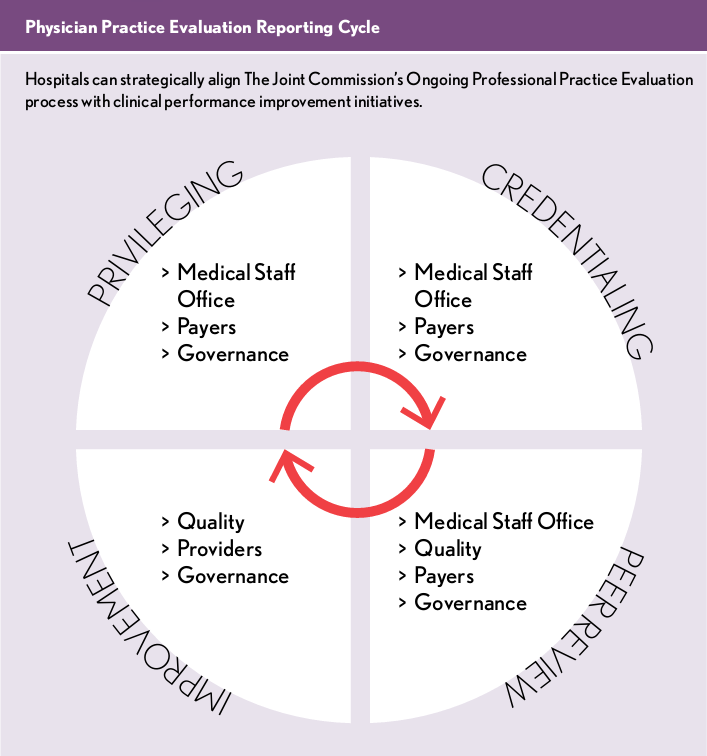Physicians recognize the need to use clinical data to identify clinical variation that adds cost without enhancing quality of care. At the same time, physicians need a high level of confidence in how data are gathered, analyzed, and deployed
The Joint Commission’s Ongoing Professional Practice Evaluation (OPPE) process, introduced in 2007, identifies a required performance-monitoring process for privileging decisions. However, the OPPE process also provides hospitals with an opportunity to use the mandated process as the basis for organization-wide clinical excellence initiatives. Leading hospitals that have data and technology tools that are trusted by physicians are able to strategically align the Joint Commission’s process with hospital-wide clinical initiatives. Providing physicians with accurate and actionable data and analytics enhances the quality and cost efficiency of patient care throughout an organization.
Ensuring Physician Trust And Confidence
As healthcare delivery transitions to value-based care models, detailed information on quality, cost, and outcomes is required. Physicians recognize the need to use clinical data, integrated through technology solutions, to identify instances of clinical variation that add cost without enhancing the quality of patient care.
At the same time, physicians need a high level of confidence in how data are gathered, analyzed, and deployed to drive discussions about clinical improvements. A process that does not address physician concerns can weaken their trust in the data and the clinical improvement objective that is possible to meet with the OPPE process.
To ensure that the OPPE process provides a solid foundation for clinical improve¬ment initiatives, hospitals should adopt a disciplined approach to data collection and display that ideally is led by physicians for physicians. Physicians should be involved in the selection of systems and tools used for data collection and presentation of clinical outcome reports. They also should review, select, and define relevant metrics by specialty and oversee performance reviews and any follow-up action needed to improve performance that falls outside targeted performance measures.
Engaging Physicians in the Measurement Process
There are five key action steps organizations should take to engage physicians in the adoption of new measurement systems, metrics, and processes.
Familiarize physicians with dashboards and reports. Review and discussion of generic dashboards and reports with data examples beyond their practice area enable physi¬cians to comment on numerous factors without becoming bogged down in the details of their own practice. Factors include content, data organization, metrics defini¬tion, severity or risk adjustment methodol¬ogy, internal or external benchmarks, and presentation of performance results.
Address common concerns. Following this initial review, encourage physicians to discuss the adequacy and applicability of the severity or risk adjustments used in the example to their own patient populations. Concerns such as “my patients are sicker” can be addressed appropriately. To ensure physicians will trust the data, encourage them to reach a consensus on data sources for their own practice areas and discuss concerns about data validity and reliability.
Identify dashboard scope and look. With the feedback from the physician review, individuals who share accountability for minimizing clinical variation and improving patient outcomes should then agree on the visual appearance and scope of data in the dashboards. These individuals could include members of the medical staff office, peer review participants, chief medical officers, medical directors, and physicians.
Reports used for OPPE and peer review should be organized by specialty and standardized for all physicians practicing within a system of hospitals or an individual facility. Dashboards showing physician-level performance, using data related to high-vol¬ume, high-cost, and high-risk conditions, are particularly critical to interdisciplinary performance improvement efforts.
Introduce performance scorecards with the physician’s own data. Once the previous step has been completed, including group and individual physician discussions and feedback, practitioners are ready to view their own data. To meet OPPE process requirements, the report should identify the physician name, specialty practice, date of reporting time frame, and internal com¬parative benchmarks. The same parameters apply if physician data are being presented as part of the interdisciplinary improvement process. A ranking of performance indicators that identifies high to low performers can prompt discussion of underlying causes for variations in care. Physicians are highly responsive to data they trust. If they are identified as low performing, they typically will want to understand how they can improve their performance and will take steps to do so.
Extend the evaluation process. Discussion with peers should identify differences among care processes, evidence-based criteria, and physician order sets, which in turn can help set the stage for performance improvement initiatives. With a solid foundation of trustworthy data and the tools in place to streamline the data collection and reporting, hospitals can leverage the OPPE process to create an evaluation cycle that supports privileging, credentialing, peer review, and ultimately, organizational improvement, thereby serving numerous stakeholders within and outside the organization.
Moving from Data Collection to Action
Leading hospitals are stretching farther and using actionable data on physician perfor¬mance to accelerate overall performance improvement. New systems and processes often must be introduced to help physicians value and respect OPPE reviews and become comfortable with using data and statistically reliable performance metrics. By building physician trust and confidence in the data collection and measurement process, hospitals can create a culture of clinical excellence, with physicians engaged in efforts to attain performance metrics, identify areas of unwarranted variation, and define evidence-based care protocols that enhance the quality and cost efficiency of patient care.


